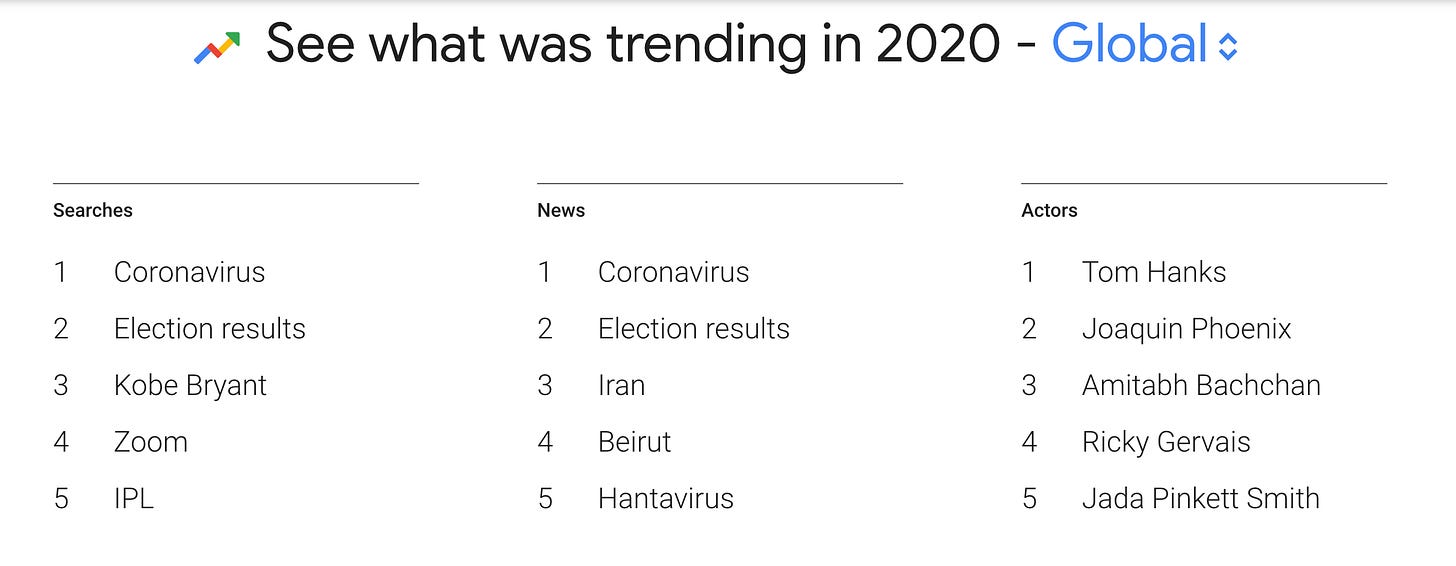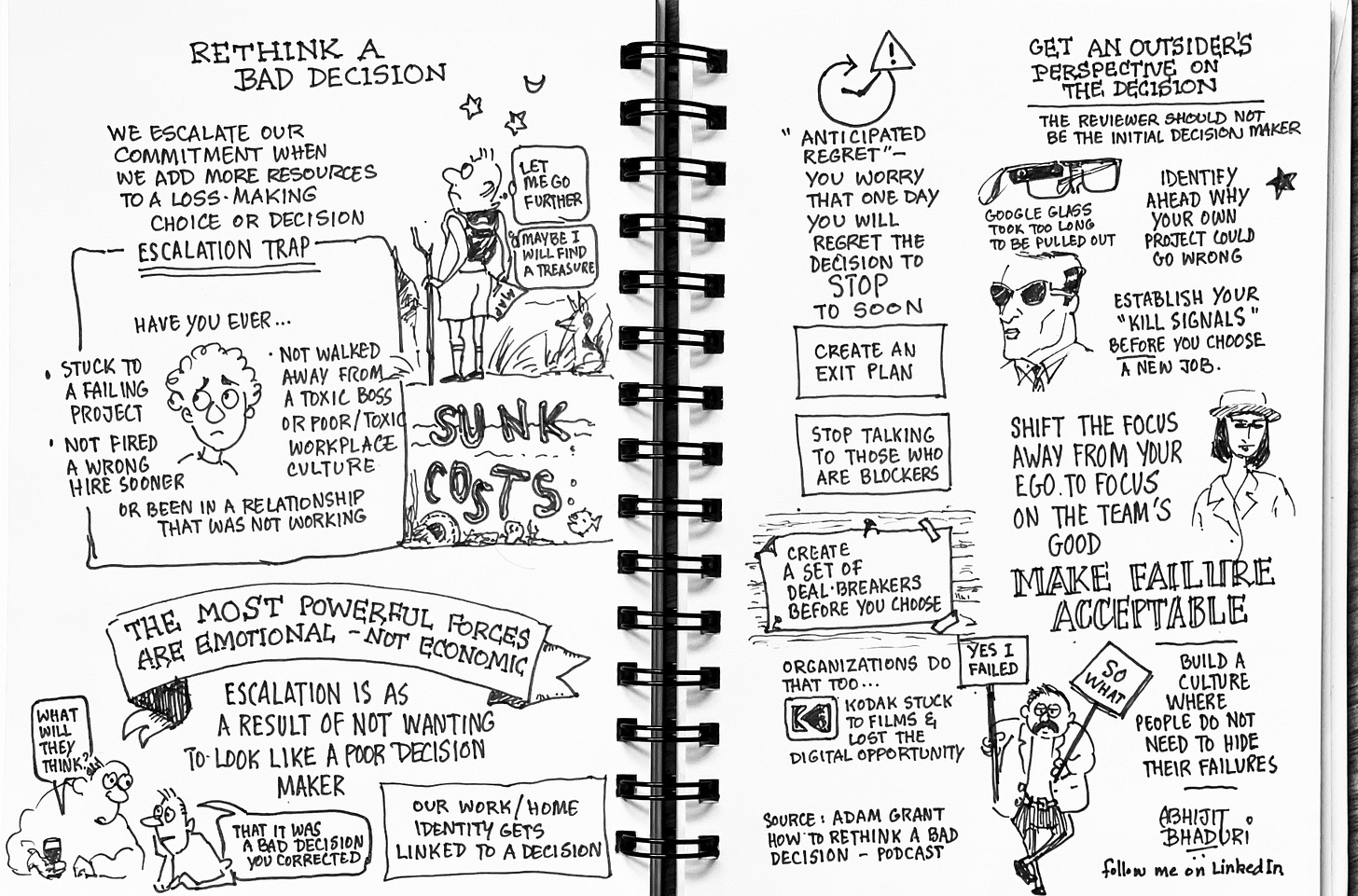Search Insights, Flexitarian, Multi-Gen, Creativity
Issue No 45
Welcome to Issue No 45. Thanks for all the appreciative mails and messages. It makes me work harder at what is clearly a labor of love. May I request you to invite someone who you think will enjoy reading this kind of stuff. Thanks for doing that. You can send them this link
“3Vs” Shaping India
In 2020, guess what was the most searched term? It was Coronavirus. People tried to make sense of the world around them by turning to Google for answers.
When these searches are clubbed together by country, it can offer some fascinating insights. In my weekly newsletter for LinkedIn (subscribe here) I wrote about the YIS 2020 (Year in Search 2020) report for India (Read it). More importantly, what does it mean for the workplaces.
In Jan 2018 I had written about the rise of “3Vs - video, visuals and voice”. Refresh your memory. In January 2021, I added the term “vernacular” to create the 4Vs that will shape the rise of “Pin-Code based jobs”. <Refresh your memory> Here is a screenshot
I was tickled pink to see Google’s Year in Search Report for 2020. They have used the term “3Vs” - something I wrote about in 2018 in my column for Business Line(read the 3Vs article). In Jan 2021, I wrote about Video, Visuals, Voice and Vernacular being the 4Vs that will drive “Pin Code based jobs.”
Google has described 3 Vs as Voice, Video and Vernacular. (read the report) Here is a sketchnote of the headlines.
My prediction: A multi-generation internet
Just like multiple generations in the workplace, the virtual world will also see multiple generations. Expect to see the generation gap to be even wider on the internet because Gen Z on the internet will not be the English speaking user. It will be someone who is far more tuned to the local issues and world around him or her. A billion new users will force the net to be more inclusive.
Read about how the world of work will shift
Remote work or “flexitarian”
What percentage of Indians are “non-vegetarian”? Instead of the strict distinction between vegetarians and non-vegetarians, there seems to be another emerging category of “flexitarians”. Post vaccination, will remote work become the norm? I believe the flexitarian label will better describe the workplace.
McKinsey says that the potential for remote work is highly concentrated among highly skilled, highly educated workers in a handful of industries, occupations, and geographies. Before the pandemic only 5% of people were working from home. Now “more than 20 percent of the workforce could work remotely three to five days a week as effectively as they could if working from an office.”
Read this to know if remote work will persist as the vaccines roll out <click here>
Rethink a bad decision
Between 1995 and its peak in March 2000, the Nasdaq index rose 400%, only to fall 78% from its peak by October 2002, giving up all its gains during the bubble. I was advised by a friend to invest in the stock market. I don’t understand anything about the stock market. But when my portfolio jumped up for three days in a row, I was convinced that my future lay in Wall Street. That may have been a day or so before the collapse began.
When my stock broker told me about the first day of the slide, I told him not to panic. “If the NASDAQ drops for three days in a row, buy more of the shares that I have in my portfolio.” When I knew I had taken a bad decision, why did I add more money to my depleting portfolio? I had fallen prey to the “Escalation Trap”.
Adam Grant’s podcast explains it and this sketchnote captures the essence.
Have you (like me) also been a victim of the “Escalation Trap”? Stayed too long in a toxic job or a toxic relationship? Drop me an email at abhijitbhaduri@live.com or leave a comment below
How to make your company innovative?
When companies craft their corporate strategy, their innovation strategy is perfectly aligned with their overall strategy. They involve of a broad range of employees — both innovators and commercialisers. They have metrics to track outcomes, financial results and cultural shifts from all this innovation activity.
So You Think You’re Not Creative
Jairam Kulkarni @Jaikulki wrote to me to share this article that lists three easy exercises you can use when you want to look for creative ideas.


The one I use a lot is to assume a different persona. I ask myself, “How would Disney solve this problem?” or “How would Amazon have solved for this challenge?”
Thinking like Disney helps me focus on the customer relationship aspect. It makes me think of the problem I want to solve for the customer. You could argue that Amazon is also a customer obsessed company. I tend to think of them as a company that knows how to solve a problem at scale.
Reframe or rebranding the problem is another technique you can use. Ask, “What can I do to turn the employees into FANS of this organisation.” I would respond promptly to their needs and make sure I never disappoint them.
In creative problem solving, the answers we get come from the questions you have asked. Asking, “How can we reduce the traffic jam at the peak office hour?” will get you one set of responses. Ask instead, “How can we discourage people from using this route between 8 and 11 every morning” and you will get a different response.
That is all for this week. See you next Monday at 9:00am and if you like this issue, do tap the heart and let me know.
Stay curious
Abhijit Bhaduri









Google taking your 3V idea. Did they give you credit? Regardless, it captures the future of content beautifully. Will have to polish my Tamil. Pun intended :-)